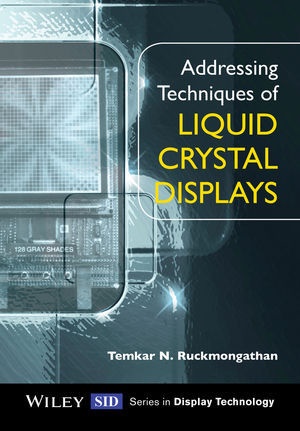Ulteriori informazioni
Unique reference source that can be used from the beginning to end of a design project to aid choosing an appropriate LCD addressing technique for a given application This book will be aimed at design engineers who are likely to embed LCD drivers and controllers in many systems including systems on chip.
Sommario
Series Editor's Foreword xiii
Acknowledgements xv
1 Introduction 1
2 Liquid Crystal Displays 3
2.1 Matrix Displays 3
2.2 Display Fonts and Formats 5
2.3 Liquid Crystals 8
2.4 Physical Properties of Liquid Crystals 9
2.5 Basics of Electro-optic Effects with Liquid Crystals 10
2.6 Twisted Nematic Effect 11
2.7 Super Twisted Nematic (STN)-LCD 13
2.8 STN-LCD with a 270° Twist (STN-270) 13
2.9 STN-LCD with a 180° Twist (STN-180) 14
2.10 In-plane Switching 14
2.11 Ferroelectric LCD (FLCD) 14
2.12 Summary 15
3 Review of Addressing Techniques 17
3.1 Addressing Techniques 17
3.2 Matrix Addressing 18
3.3 Nonlinear Characteristics 19
3.4 Cross-Talk in a Matrix LCD 21
3.5 Driving Matrix Displays 22
3.6 Bi-phase Addressing 23
3.7 Line-by-Line Addressing (LLA) 25
3.8 Half-Select Technique 27
3.9 Two-Third-Select Technique (TTST) 29
3.10 Selection Ratio (SR) and the Maximum Selection Ratio 30
3.11 Limitations of Matrix Addressing 37
3.12 Principle of Restricted Pattern Addressing 38
3.13 Pulse Coincidence Technique (PCT) 40
3.14 Pseudo Random Technique (PRT) 42
3.15 Restricted Pattern Addressing Technique (RPAT) 43
3.16 Addressing Technique for Dial Type Displays 47
3.17 Frame Frequency 47
3.18 Large Area Display 48
3.19 Dielectric Relaxation 48
3.20 Supply Voltage of Drivers 49
3.21 Nonuniformity Due to Resistance Mismatches 49
3.22 Need for Multiline Addressing Techniques 51
4 Binary Addressing 53
4.1 Principle 53
4.2 Binary Addressing Technique (BAT) 55
4.3 Analysis of the BAT 58
4.4 Practical Aspects of the BAT 66
4.5 Drivers for Driving the LCD with the BAT 69
5 Orthogonal Functions and Matrix Addressing 71
5.1 Orthogonal Functions 71
5.2 Multiplexing 78
5.3 Matrix Addressing 80
5.4 Line-by-Line Addressing 81
5.5 Multiline Addressing 82
5.6 Discussion 85
6 Active Addressing 87
6.1 Principle 87
6.2 Active Addressing Technique (AAT) 87
6.3 Summary 93
7 Hybrid Addressing 95
7.1 Principle 95
7.2 Hybrid Addressing Technique (HAT) 96
7.3 Analysis of the HAT 98
7.4 Drivers of the Hybrid Addressing Technique 103
7.5 Discussion 103
8 Improved Hybrid Addressing 105
8.1 Principle 105
8.2 Improved Hybrid Addressing Technique (IHAT) 106
8.3 Analysis of IHAT 108
8.4 Discussion 115
9 Improved Hybrid Addressing Special Case 3 119
9.1 Principle 119
9.2 Analysis 120
9.3 Summary 126
10 Improved Hybrid Addressing Special Case 4 127
10.1 Principle 127
10.2 Analysis 127
10.3 Summary 136
11 Sequency Addressing 137
11.1 Principle 137
11.2 Technique 137
11.3 Discussion 141
12 Restricted Pattern Addressing 145
12.1 Principle 145
12.2 Technique 145
12.3 Analysis 149
12.4 Summary 152
13 Review of Methods to Display Greyscales 153
13.1 Greyscales in Liquid Crystal Displays 153
13.2 Basics of Greyscale 153
13.3 Frame Modulation 155
13.4 Pulse Width Modulation 157
13.5 Row Pulse Height Modulation 157
13.6 Data Pulse Hei
Info autore
Temkar N. Ruckmongathan, Raman Research Institute, Bangalore, IndiaDr. Ruckmongathan is a Senior Professor at the Raman Research Institute, Bangalore, India. He has over 30 years' experience of research and development in the area of addressing techniques for driving LCDs. Professor Ruckmongathan has authored approximately 50 publications on driving matrix LCD. He has 16 US and European patents.
Riassunto
Unique reference source that can be used from the beginning to end of a design project to aid choosing an appropriate LCD addressing technique for a given application This book will be aimed at design engineers who are likely to embed LCD drivers and controllers in many systems including systems on chip.

